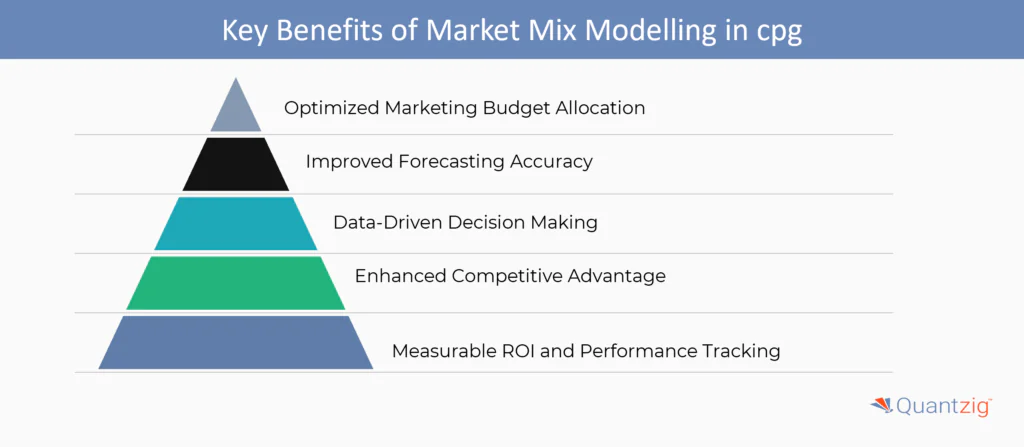Written by: Medha Banerjee
Table of Contents
Introduction to Marketing Mix Modeling in CPG
Over the last couple of years, the consumers’ behavior and needs have been changing, and organizations are embracing technologies to meet the ever-growing array of these demands. The shift from conventional shopping to advanced online retailing can be attributed to factors such as the rise of middle-class population, urbanization, and globalization. To keep pace with the altering preferences of the customers, leading businesses in the Consumer-packaged goods industry are planning to adjust their operating models with that of the competitors. Moreover, as retailers consolidate, and e-commerce platforms increase, CPG companies are relying on winning go-to-market strategies to retain their position in the market.
Book a demo to experience the meaningful insights we derive from data through our analytical tools and platform capabilities. Schedule a demo today!
Request a free demoHow Quantzig Implemented the Marketing Mix Modelling in CPG for its Client?
| Category | Details |
|---|---|
| Client Details | Prominent player in the consumer-packaged goods (CPG) industry |
| Challenges | Sought actionable insights into sales, market share, and marketing ROI. Aimed to optimize marketing mix for effectiveness, understand the impact of online media on sales, and measure the value of marketing inputs for long-term revenue. |
| Solutions Offered | Provided market mix model using multiple regression techniques to predict sales outcomes and determine net effect of marketing campaigns on profits. Attributed impact of marketing across all channels to enhance return on investment and promote sales and marketing efficiency. |
| Impact Delivered | Improved marketing efficiency and effectiveness. Enhanced return on investment and long-term revenue. Promoted better allocation of resources and optimized investments to drive profit. |
The client
A prominent player in the consumer-packaged goods industry
The Business Challenge
The client, a prominent CPG company with considerable retail stores, spread globally, wanted to gain actionable insights into the sales, market share, and marketing ROI. The CPG company wanted to identify the strengths and weaknesses and optimize their marketing mix to improve the effectiveness of marketing campaigns on business performance. Moreover, with the help of market mix model engagement, the client also wanted to understand the impact of online media on sales and optimize investments to drive profit. The primary objective of the client was to measure the potential value of all marketing inputs and make investments to increase long-term revenue.
The Business Impact using Quantzig Solutions
Strategies that we recommend based on our analysis to promote sales and increase marketing efficiency for the client.
Beyond traditional marketing campaigns, the market mix model solution offered by Quantzig helped the prominent client in the CPG industry, leverage the use of multiple regression techniques to predict the outcome of sales. The solution also helped the client determine the net effect of their marketing campaigns on company’s profits. The engagement also focused on attributing the impact of marketing activity across all channels to further enhance the return on investment.
Marketing Mix Modeling (MMM) Predictive Insights:
The engagement offered by Quantzig assisted the CPG company to quantify the impact of sales on marketing activities. The marketing mix modelling solution also focused on developing an attribution model based on the past marketing spend and sales. Through this model, the CPG company could optimize the future spend and improve the overall business efficiency.
Reasons why your CPG business should be using marketing mix Variable modelling

Using marketing mix modeling (MMM) can significantly enhance the effectiveness of your Consumer-Packaged Goods (CPG) business in various ways:
1. Data-Driven Decision Making:
It allows your CPG business to base its marketing decisions on concrete data rather than assumptions or guesswork. By analyzing historical data on marketing variables such as advertising spend, distribution channels, and pricing strategies, coupled with consumer behavior and market dynamics, you can derive actionable insights to optimize your marketing budget allocation. This data-driven approach enables you to make informed decisions that lead to better results and improved ROI.
2. Optimizing Marketing Spend:
With MMM, you can accurately measure the impact of different marketing channels, including digital advertising, social media, TV advertising, and print advertising, on sales volume and market share. By understanding the contribution of each channel to your overall sales performance, you can optimize your marketing spend to maximize ROI. This includes identifying the most cost-effective channels, adjusting advertising campaigns based on their effectiveness, and reallocating budget to areas with higher potential for customer acquisition.
3. Forecasting Accuracy and Scenario Analysis:
It enables you to forecast future sales and market share with greater accuracy by incorporating factors such as consumer demand elasticity, competitor prices, and industry benchmarks into your models. Additionally, you can conduct scenario analysis to simulate the potential impact of different marketing strategies and external factors on your business outcomes. This allows you to identify potential risks and opportunities in advance, enabling proactive decision-making to drive growth and profitability.
4. Enhanced Collaboration Between Teams:
It facilitates collaboration between your product, finance, and marketing teams by providing a common framework for evaluating the impact of marketing campaigns and pricing strategies on business performance. By aligning these cross-functional teams around shared objectives and metrics, you can ensure that marketing efforts are integrated with product development and financial planning to maximize profitability and market share.
5. Continuous Improvement and Adaptation:
By leveraging a platform like Quantzig, which specializes in MMM and AI-driven analytics, your CPG business can continuously monitor and adapt its marketing strategies based on real-time data and insights. This iterative approach enables you to quickly respond to changes in consumer behavior, market dynamics, and competitor actions, ensuring that your marketing efforts remain agile and effective in an evolving landscape.
Get started with your complimentary trial today and delve into our platform without any obligations. Explore our wide range of customized, consumption driven analytical solutions services built across the analytical maturity levels.
Start your Free Trial todayWhat are The Factors That Influence the Growth of The CPG Industry using MMM modeling?
Several factors converge to shape the growth trajectory of the Consumer Packaged Goods (CPG) industry. Key among these are market changes and consumer preferences, which pivotally influence product demand and market dynamics. Major players in the CPG sector, alongside emerging DTC (direct-to-consumer) brands, leverage data analytics and sophisticated marketing analytics tools to decipher these trends.
Historical sales data serves as a compass, guiding strategic decisions and optimizing promotions. Moreover, the proliferation of digital advertising channels amplifies brand visibility and consumer engagement. By aligning strategies with essential KPIs and adapting to evolving market landscapes, CPG companies capitalize on opportunities and drive sustained industry growth.
Some of the factors influencing the growth of the consumer-packaged goods industry are:
Innovations:
As the current retail landscape is witnessing a shift toward digitization, prominent companies are developing, testing and iterating innovative ideas to optimize customer engagement. Moreover, it becomes essential for the companies to re-align their product offerings to meet the growing demands of the customers.
M&A activity:
With the growing number of e-commerce platforms, a considerable number of companies are looking forward to expand across geographies to potentially reach out to different markets. Moreover, organizations are further collaborating with reputed firms to drive sales and increase their return on investment.
To address such challenges and optimize the marketing campaigns to enhance their business efficiency, leading organizations are leveraging marketing mix modeling solutions. The solution helps businesses identify the market effectiveness and streamline their marketing campaigns to enhance the business performance.
Best Ways to Create and Implement CPG Marketing Strategies
This involves a series of steps aimed at analyzing the effectiveness of various marketing variables and determining their impact on key business outcomes such as sales volume, market share, and ROI. Here are the steps involved in Market Mix Modeling:
1. Data Collection and Preparation:
The first step in MMM is gathering relevant data from multiple sources, including internal databases, external market research firms, and third-party data providers. This data typically includes information on marketing variables such as advertising spend, pricing strategies, distribution channels, and competitor prices, as well as sales data and consumer behavior metrics. Once collected, the data needs to be cleaned, standardized, and organized to ensure accuracy and consistency before proceeding to the analysis phase.
2. Model Specification and Estimation:
In this step, the MMM analyst defines the mathematical model that will be used to quantify the relationship between marketing inputs (e.g., advertising spend, pricing) and business outcomes (e.g., sales volume, market share). This typically involves selecting appropriate regression techniques, such as multiple linear regression or Bayesian methods, and specifying the functional form of the model. The model is then estimated using statistical software, which involves fitting the model to the historical data to obtain parameter estimates and assess the significance of the relationships between variables.
3. Scenario Analysis and Optimization:
Once the model has been estimated, it can be used to conduct scenario analysis and optimization to evaluate the potential impact of different marketing strategies on business outcomes. This involves simulating various scenarios, such as changes in advertising spend, pricing strategies, or distribution channels, and assessing their effects on metrics like sales volume, market share, and profitability. By identifying the most effective marketing mix, CPG marketing strategy, and pricing strategy, businesses can optimize their resource allocation to maximize ROI and achieve their growth objectives.
4. Data-Driven Insights and Informed Decision Making:
The insights generated from the MMM analysis provide valuable information for making informed marketing decisions. By understanding the relative effectiveness of different marketing channels, the elasticity of consumer demand, and the competitive landscape, businesses can allocate their marketing budget more strategically, adjust pricing strategies to better reflect market dynamics, and tailor their advertising campaigns to target specific customer segments. This data-driven approach enables businesses to make evidence-based decisions that are more likely to yield positive results and drive growth and profitability.
5. Continuous Monitoring and Improvement:
Market dynamics and consumer behavior are constantly evolving, so it’s essential for businesses to continuously monitor the effectiveness of their marketing strategies and adjust them accordingly. This involves regularly updating the MMM model with new data, refining the model parameters to reflect changes in the market environment, and conducting ongoing analysis to identify opportunities for optimization. By adopting a cyclical approach to MMM, businesses can stay agile and responsive to changes in the competitive landscape, ensuring that their marketing efforts remain effective and competitive over time.
Crafting and executing effective marketing strategies within Consumer-Packaged Goods (CPG) companies necessitates a meticulous approach aligned with prevailing market dynamics and consumer preferences. Leveraging robust data analytics and cutting-edge marketing analytics tools, major players in the CPG sector can glean actionable insights into evolving market changes and consumer behavior. Integrating key performance indicators (KPIs) facilitates the measurement of campaign efficacy, while historical sales data guides strategic decision-making. Digital advertising emerges as a pivotal avenue to engage with consumers directly, especially for DTC (direct-to-consumer) brands, optimizing promotional efforts and enhancing brand visibility. By leveraging these insights, CPG companies can craft and implement agile marketing strategies, effectively navigating market complexities and driving sustained growth.
Key Benefits of Market Mix Modelling in CPG

Market Mix Modeling (MMM) offers several key benefits to Consumer Packaged Goods (CPG) businesses, helping them optimize their marketing strategies and drive growth and profitability. Here are five key benefits of MMM in the CPG industry:
1. Optimized Marketing Budget Allocation:
It enables CPG businesses to allocate their marketing budget more effectively by providing insights into the relative impact of different marketing variables, such as advertising spend, distribution channels, and pricing strategies, on key performance metrics like sales volume and market share. By understanding which marketing channels deliver the highest ROI and which pricing strategies resonate most with consumers, businesses can optimize their resource allocation to maximize profitability. This ensures that marketing dollars are spent where they will have the greatest impact, leading to improved ROI and better overall business results.
2. Improved Forecasting Accuracy:
MMM helps CPG businesses improve forecasting accuracy by incorporating factors such as consumer behavior, competitor prices, and market dynamics into their models. By analyzing historical data and identifying patterns and trends, businesses can better predict future sales volume and market share, enabling more accurate demand planning and inventory management. This reduces the risk of stockouts or excess inventory, leading to cost savings and improved operational efficiency. Additionally, accurate forecasting allows businesses to adapt their marketing strategies in real-time to capitalize on emerging opportunities or mitigate potential risks.
3. Data-Driven Decision Making:
MMM enables CPG businesses to make data-driven decisions by providing actionable insights into the effectiveness of their marketing efforts. By quantifying the impact of different marketing variables on business outcomes, businesses can identify areas for improvement and make informed decisions about where to allocate resources. This helps businesses stay ahead of the competition and respond quickly to changing market conditions, ensuring that their marketing strategies remain relevant and effective. Additionally, data-driven decision-making fosters a culture of continuous improvement within the organization, driving innovation and growth over time.
4. Enhanced Competitive Advantage:
This technique gives CPG businesses a competitive advantage by helping them identify and exploit market opportunities more effectively. By understanding consumer behavior, competitor prices, and market dynamics, businesses can develop targeted marketing campaigns and pricing strategies that resonate with their target audience and differentiate their brand from competitors. This allows businesses to capture market share and increase brand loyalty, ultimately driving revenue and profitability. Additionally, MMM enables businesses to stay agile and responsive to changes in the competitive landscape, ensuring that they remain ahead of the curve and maintain their competitive edge over time.
5. Measurable ROI and Performance Tracking:
It provides CPG businesses with a clear understanding of the ROI of their marketing efforts, allowing them to measure the impact of different marketing variables on key performance metrics such as sales volume and market share. By quantifying the ROI of each marketing channel and campaign, businesses can identify areas of underperformance and make adjustments to improve results. This enables businesses to track their performance over time and evaluate the effectiveness of their marketing strategies, ensuring that resources are allocated to initiatives that deliver the highest return on investment. Additionally, measurable ROI allows businesses to justify marketing spend to stakeholders and demonstrate the value of their marketing efforts to the organization.
In the competitive Consumer Packaged Goods (CPG) companies, leveraging Market Mix Modeling (MMM) yields multifaceted advantages. By harnessing data analytics and sophisticated marketing analytics tools, CPG giants and DTC (direct-to-consumer) brands alike can discern granular insights into market changes and evolving consumer preferences. MMM enables precise evaluation of the impact of various marketing initiatives, including digital advertising campaigns and promotional strategies, by analyzing historical sales data and identifying key performance indicators (KPIs).
Experience the advantages firsthand by testing a customized complimentary pilot designed to address your specific requirements. Pilot studies are non-committal in nature.
Request a free pilotConclusion
In conclusion, Quantzig’s expertise in Marketing Mix Modeling (MMM) proved invaluable in helping our prominent client in the Consumer-Packaged Goods (CPG) industry optimize their marketing spend. By leveraging advanced analytics and data-driven insights, we enabled the client to make informed decisions regarding their marketing strategies, leading to improved ROI and better business results. Our MMM approach provided actionable recommendations for optimizing marketing budget allocation, enhancing forecasting accuracy, and driving growth and profitability. Through continuous monitoring and optimization, we empowered the client to stay ahead of the competition and adapt to changing market dynamics effectively.





